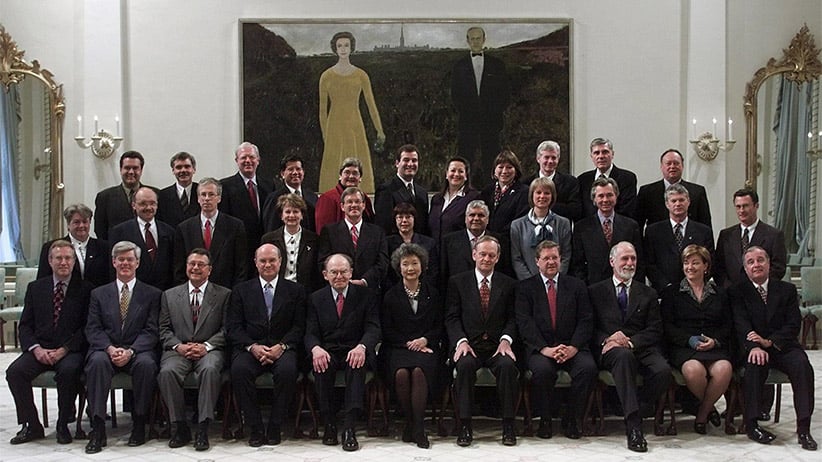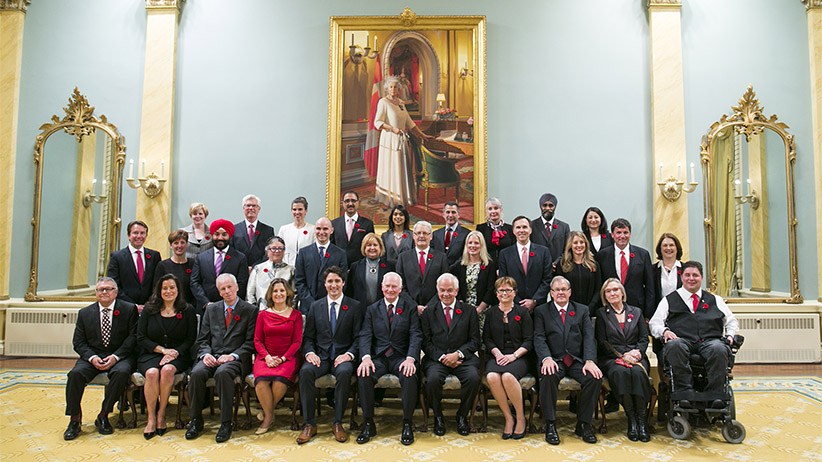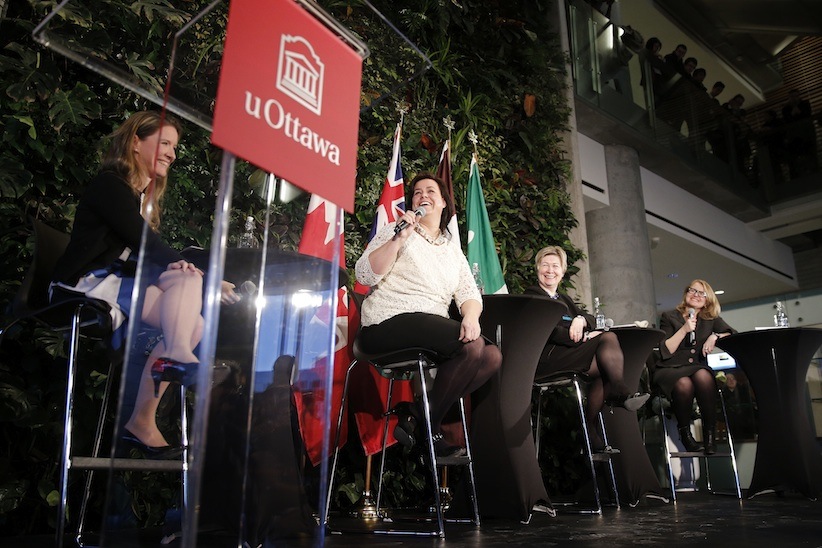Women in politics: We’re not as equal as we think we are
‘Because it’s 2015?’ Maybe not: Recent appointments paint an overly rosy picture of women in Canadian politics
OTTAWA, Nov. 4, 2015 — Newly elected Canadian Prime Minister Justin Trudeau, fifth left first row, takes a group photo with his cabinet ministers at Rideau Hall in Ottawa, Canada, Nov. 4, 2015. Justin Trudeau was sworn in as Canada’s 23rd prime minister and named a 31-member cabinet here Wednesday. (Chris Roussakis/Xinhua News Agency/Getty Images)
Share

One day when Penny Collenette was director of appointments for Prime Minister Jean Chrétien, her executive assistant slunk into her office clutching a list. “You’re not going to like this,” she said. Collenette looked at it: 18 people recommended for an advisory group on a sensitive public policy issue. All of them were men.
Before the Liberal government was elected in 1993, they made a campaign promise to appoint more women. When they took office, Collenette asked to see the numbers: of about 3,000 people appointed by governor-in-council — deputy ministers, heads of agencies, Crown corporations, ambassadors, judges, returning officers and commission members — women made up between 26 and 29 per cent. Over the first year or so, Collenette kept an eye on that number like it was a stock ticker. With each list of proposed names, the proportion of women nudged upward, bit by bit.
She knew what this list of 18 men was going to do to the progress they’d made. She had a good relationship with the minister in question — even years later, she won’t say which one — so she called him up to say his department needed to do better. He whined a little, but three weeks later produced a new list: nearly half were women, and a few were Indigenous women, too. By the time Collenette left in 1997, the proportion of women in those posts had reached 39 per cent. “In a way, I suppose it was just naïveté,” she says. “We said we were going to do it, so I thought I guess we’d better do it. And of course, personally I wanted to.”
Two decades on, lagging progress — the ranks of women in top government positions is now lower than when Collenette left — has spurred a raft of highly visible attempts to rebalance the scales in Canadian politics and public service. The blunt, by-the-numbers approach of affirmative action is an imperfect and sometimes controversial way to move the ball forward, but — particularly in politics — it may be the only way to upend the entrenched systems that favour men and overlook women. “That we’re still so far behind on this one suggests there are still some really pernicious ideas about women in politics,” says Melanee Thomas, a professor of political science at the University of Calgary. A large and growing number of countries employ gender quotas in politics, and many have seen dramatic improvements in representation as a result. Canada is well behind, and the country’s ranking on gender equity has been slipping for years. The major roadblock is also where the clearest solution lies: with political parties and nominations. “If parties demanded that this would be different, it would be different,” Thomas says.

The new Liberal government set a template when Prime Minister Justin Trudeau introduced a gender-balanced cabinet in November, justified with nothing more than the verbal shrug, “Because it’s 2015.” Jean Charest did the same in 2007 in Quebec, as did Alberta Premier Rachel Notley when she was elected in May 2015, but Trudeau’s cabinet attracted enormous attention. In March, when the Prime Minister named seven new senators, three were women (they make up 39 per cent of the upper chamber). And in mid-July, new diplomatic appointments included 13 men and 13 women (in G20 countries, there are now 15 men and three women as Canada’s heads of mission, with a new ambassador yet to be named in Indonesia). A list of governor-in-council appointees by the new government is not available, but as of January 2015, ongoing political science research by Stephanie Mullen at the University of Ottawa shows that women made up 31.3 per cent of all existing appointments. The Trudeau government says one of its goals in a more public process around appointments is to “achieve gender parity.” So gender-balanced lists are the new normal. “You can expect to see appointments that meet these criteria,” a spokesman for the Prime Minister’s Office says.
The Globe and Mail reported recently that the Trudeau government wants to appoint a bilingual, female, visible minority judge to the Supreme Court — giving the court a female majority for the first time — but given the expectation that the candidate will be from Atlantic Canada, the government is having a difficult time finding someone. Even at the provincial level, Ted McMeekin, a Hamilton MPP, recently announced he was stepping down from Kathleen Wynne’s cabinet to “make room at the table” for women. Wynne subsequently split McMeekin’s portfolio and appointed two men to replace him, but her shuffle resulted in a net gain of four women. And earlier this spring, MSNBC host Rachel Maddow asked Hillary Clinton — the newly minted Democratic nominee and first woman in history to contend for the American presidency on behalf of a major party — whether she would mirror Trudeau’s cabinet. “I am going to have a cabinet that looks like America, and 50 per cent of America is women, right?” Clinton replied, to loud applause.
From our weekly politics podcast: Nancy Peckford, of Equal Voice, on political equality
The Canadian military, too, is aiming for women to make up 25 per cent of its enlisted forces (they currently sit at 15 per cent). Lt-Gen. Christine Whitecross, chief of military personnel, has been tasked with increasing female enrolment by one per cent a year over the next decade; that amounts to twice the number of women who are enlisting now. “It’s going to be tough,” she says. “But we’re putting all effort into this, because if we don’t have a target and we don’t put dates on it, I fundamentally believe we’re just not going to get there.”
MORE: Meet the first female general from the combat arms trades
In politics, setting gender targets is common outside North America. At least 112 countries have voluntary party quotas for selecting nominees, and 54 nations legislate candidate quotas, according to the Quota Project. Trudeau’s much-feted cabinet stands against the backdrop of the House of Commons itself, where women occupy 88 of 338 seats, or 26 per cent — a bump of just one percentage point over the previous Parliament. Canada has tumbled from 21st in 1997 to 62nd in Inter-Parliamentary Union rankings as others countries make swifter progress.
Cabinet members have more influence than MPs, but Karen Bird, a professor of political science at McMaster University, sees appointing a diverse cabinet as “low-hanging fruit,” because it’s much easier than putting in the local legwork to find more women to run in the first place. “Trudeau was really fortunate that he had a really deep pool of very talented women MPs who were elected to his caucus. But that’s not always going to happen by accident. It does raise questions, if your target is gender parity in cabinet, but you haven’t really done anything to recruit these talented women,” she says. “If you just have it in cabinet but not the base, it’s not clear what good that does.”
The NDP is unusual among Canadian political parties in having an explicit goal to run 50 per cent female candidates; in 2015, they led the national parties with 43 per cent female candidates, according to Equal Voice. The Liberals aimed to run one-third female candidates and fell just short, with women in 31 per cent of ridings. The Greens had 39 per cent female candidates, and the Conservatives 20 per cent.
Thomas likes to dissect the chronic shortage of female candidates with stark math. Her thinking goes like this: there are 338 seats in the House of Commons, so to run gender-balanced slates, Canada’s four national political parties would each need to recruit 169 women. “Seriously, the moment somebody says, ‘The problem is that women don’t want to come forward,’ they are actually saying 169 women who are competent enough and willing enough don’t exist within each party’s orbit,” Thomas says, her voice dripping with the absurdity of this. “That’s 507 women. Do we really want to say that 507 qualified, competent women who are prepared to run for office don’t exist in Canada?”

Theoretically, more women on ballots means more women in office, as research shows voters have no bias against them as candidates. But Thomas’s own research shows that parties are not setting up female candidates for a fair fight. In 2011, she found that all three national parties (the Green party did not run a full slate) placed more women than men in “unwinnable” ridings. Women were more likely to run in another party’s stronghold (59 per cent vs. 47 per cent for men), less likely to run in competitive battlegrounds (24 per cent vs. 28 per cent) and less likely to run in their own party’s strongholds (17 per cent vs. 25 per cent) than men.
These patterns likely rest on human nature and networks more than any nefarious plot. Women are less likely to belong to political parties or be involved in local parties than men. So when riding associations look for nominees, they come up with male-heavy lists because there are more men involved at the grassroots level and that’s who they know.
Once candidates are selected, what we see becomes what we expect. What we see in our politicians, again and again, is a male who is older, whiter, more educated and with a higher status job than the average Canadian. That’s the prototype of a “good” candidate, Thomas says, and in turn shapes decisions at the riding level about who to field in competitive races and who ends up a sacrificial lamb. Her findings suggest this all feeds on itself: parties put more women into unwinnable contests, then look at their results after election day and conclude women are less likely to win, so they continue to shunt them into unfavourable races.
Thomas and others who work in this area often think of this issue in terms of supply and demand. Given that Canadian women have been out-graduating men in universities since the 1990s and in the workforce at critical mass much longer than that, it’s not likely a short supply of qualified women candidates is the problem. So, the only way to disrupt these entrenched patterns in local nominations is to increase the demand for female candidates—through parity slates and party quotas. “Parties in Canada who don’t at least work toward that should have to answer for it,” Thomas says. That mirrors “comply or explain” policies that most Canadian provinces and territories have adopted for publicly traded companies, requiring them to either demonstrate gender diversity in their corporate boards or account for it. (A 2014 report by Catalyst showed that women occupied 20.8 per cent of board seats in Canada; Norway leads the world, with 35.5 per cent women.)

France provides an example of how effective quotas in politics can be. In 1999, women made up 11 per cent of national representatives—“shockingly low” for a country that considers itself the birthplace of democracy, Bird says. In 2000, France introduced a parity law that required parties to field gender-balanced slates, or face financial penalties. At first, parties flouted the law and absorbed the fines, but eventually there was a deeper shift among French voters.“It just became more publicly shameful for parties to not have a reasonable number of women,” says Bird. France now sits just ahead of Canada in international rankings, with 26.2 per cent women in its national assembly.
The French law flew in the face of the deep societal belief — enshrined in the constitution — that there could be no distinctions made between French citizens, not even to ensure equal representation. But, Bird points out, Canada has a long history of ensuring representation of different groups: we speak openly about balancing geography or language when it comes to cabinets or judges, but somehow balancing gender meets with resistance. “We have this strong assumption that if you have any kind of special measures for women, that it’s anti-democratic,” she says. Even Equal Voice, the group devoted to getting more women into public office in Canada, exhibits a certain reluctance. “Certainly it’s important to have targets and goals,” says Nancy Peckford, the executive director. “Even within our own organization — which is a multi-partisan organization — many don’t regard quotas as an effective vehicle because of the anticipated backlash and the fact that for many, many political party cultures, it wouldn’t fly.”
A study published last year examined all-women shortlists (AWS), a controversial policy introduced by Britain’s Labour Party in 1993, in which only women are considered as candidates in half the ridings the party is likely to win. The paper found evidence to reject all nine of the most common criticisms of the practice. Researchers found that in most recent elections, AWS candidates had more political experience on average than other MPs, male or female; the measure had not affected the party’s electoral fortunes; and women elected through AWS ask more questions and speak more often in debates than other MPs.
That notion that affirmative action runs counter to merit is perhaps the most entrenched argument against it. Gwen K. Young, director of the Global Women’s Leadership Initiative and Women in Public Service Project at the Wilson Center in Washington finds that a very easy argument to dismantle. Highly qualified women exist in droves, she argues, and there are barriers in the traditional pipeline that prevent them from being drawn in. “It is preposterous to think there are not qualified women candidates,” she says. “You’re just not seeing them, you’re not seeing them everyday in your group of friends, where you are.”
Collenette, now an adjunct law professor at the University of Ottawa, is fed up with the whole argument. “I honestly can’t believe we are still having this discussion,” she says. “When men were put in cabinet or anywhere, all these years, did anyone ask if they had merit? It’s an unjust comparison if a woman is appointed and someone says, ‘Oh, but does she have merit?’ ” As far as Collenette is concerned, women did all the work to address that patronizing question a long time ago, and it’s time to stop asking it.
When she was in the Prime Minister’s Office, she had a tiny staff and a budget to match, so they had to be creative about how they went looking for impressive women candidates. One tactic that paid off was subscribing to trade magazines aimed at women in fields like architecture and engineering: they were a goldmine for leads. Once, Collenette spotted a story about a female engineer in eastern Canada and called ministers from the region: no one had thought to suggest her, but everyone agreed she was fantastic. The real lesson Collenette learned while she was searching for overlooked women and trying to broaden the ranks of people who ran the country was this: it was easy. “Oh, it can be done,” she says. “It can be done without a great deal of fussing. It’s there — it just requires nurturing, mentoring, some work, but for the most part, people are pretty okay with it. It’s not a big deal.”